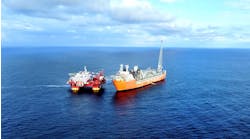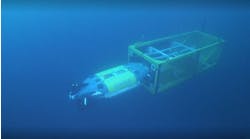Offshore staff
OSLO, Norway – The Norwegian Petroleum Safety Authority (PSA) has completed its investigation of a hydrocarbon leak from the S template serving the Åsgard development in the Norwegian Sea.
Leakage occurred on March 10, 2017, during a program to reconnect well S-4 on the S template, which is tied back to the Åsgard A production facility, from the semisubmersibleDeepsea Bergen.
The well had been disconnected and a blind installed at the connection point on the manifold. The leak occurred when the blind was removed.
According to the PSA, the isolation valve from the flowline on the manifold to well S-4 was open, allowing gas and condensate to flow to the sea. Wells producing to the flowline were then shut, with the leak continuing until pressure in the flowline had equalized with seabed pressure, which took around 20 minutes.
As a result of this incident, gas and condensate escaped to the sea and the atmosphere. However, favorable currents and the wind direction meant that little gas flowed to theDeepsea Bergen.
Statoil’s figures suggest around 31 metric tons (34 tons) of gas and 1.6 metric tons (1.7 tons) of condensate were discharged, with production from the S template subsequently being halted for 28 days.
Gas hazard analyses showed that the discharge could have led, under different weather conditions, to ignitable gas enteringDeepsea Bergen’s moonpool. These analyses show that ignition of the gas would not have threatened the integrity of the facility, but could have led to fatalities had there been personnel in the area.
According to PSA, various factors contributed to the failure to detect that the isolation valve was open before removing the blind, and to test and secure this valve as a barrier.
- No barriers were in place to prevent discharges to the sea during work on the template.
- In connection with planning and executing the operations on well S-4, important contributors to risk and changes in risk were not identified and assessed.
- Responsibility for testing isolation valves was not clearly defined and coordinated for the operations being conducted.
- Personnel involved had little knowledge of barrier requirements in governing documentation for work on the template.
- Requirements in governing documents concerning isolation valves were not clarified in the operational procedures.
PSA has asked Statoil to explain how it plans to address these issues.
09/12/2017


